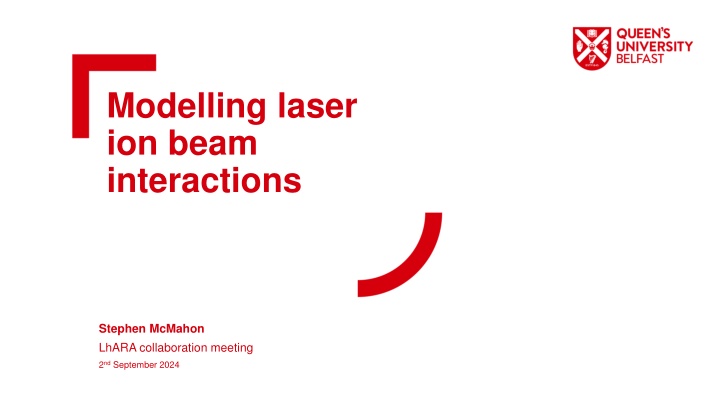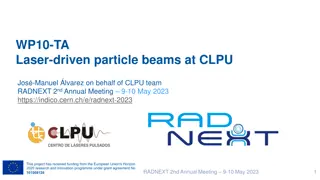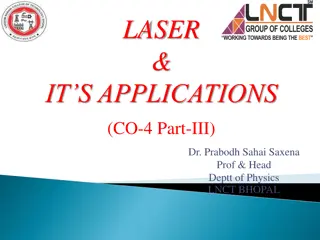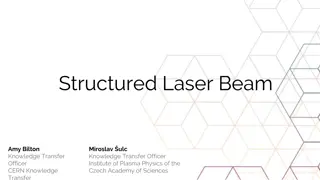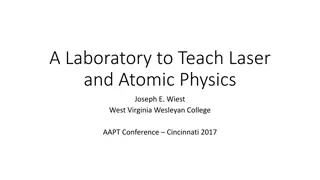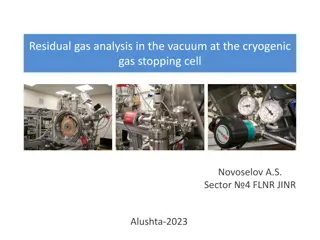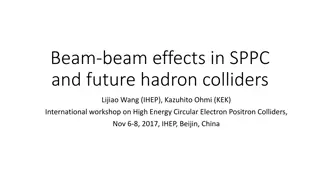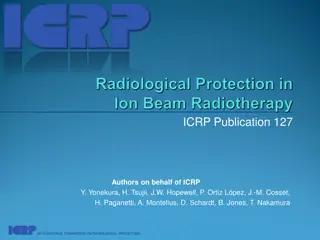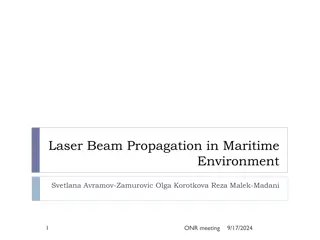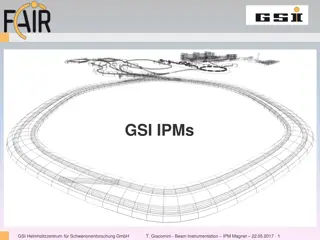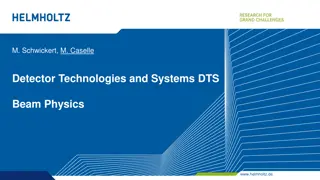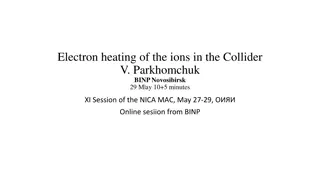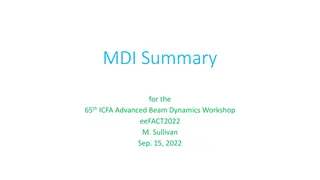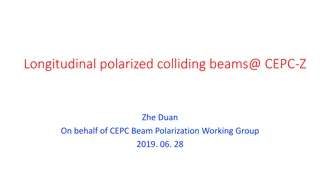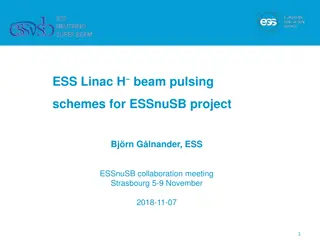Modelling Laser-Ion Beam Interactions for LhARA Collaboration Meeting
This session will focus on the simulation and analysis of laser-ion beam interactions, led by Stephen McMahon, during the LhARA collaboration meeting held on 2nd September 2024. Researchers will discuss theoretical models and practical implications in this specialized field of study.
Download Presentation

Please find below an Image/Link to download the presentation.
The content on the website is provided AS IS for your information and personal use only. It may not be sold, licensed, or shared on other websites without obtaining consent from the author.If you encounter any issues during the download, it is possible that the publisher has removed the file from their server.
You are allowed to download the files provided on this website for personal or commercial use, subject to the condition that they are used lawfully. All files are the property of their respective owners.
The content on the website is provided AS IS for your information and personal use only. It may not be sold, licensed, or shared on other websites without obtaining consent from the author.
E N D
Presentation Transcript
Modelling laser ion beam interactions Stephen McMahon LhARA collaboration meeting 2ndSeptember 2024
Key outstanding questions Laser-accelerated beams Conventional RT Conventional radiotherapy is delivered over a timescale of minutes, where physico-chemical interactions happen largely in isolation. FLASH has suggested some cellular effects can be modulated at timescales of <1 s, whereas laser-accelerated beams can deliver irradiations entirely within the physical stage of interaction. FLASH It s unclear how this may affect both physical and chemical effects of radiation. Schematic illustration of time- and length-scales associated with different aspects of radiation responses.
Modelling inter-track interactions We used Geant4/Topas-nBio to simulate interactions of proton beams in small target samples. To explore potential for interactions between tracks, we calculated both the distribution of physical energy deposition around the track, as well as the generated radical species as a function of time. Left: Schematic illustration of proton beam incident on small water phantom. Right: Illustration of energy deposition by a pencil beam of fifty 100 MeV protons, and evolution of generated radical species (solvated electron (green), hydroxyl radical (orange), hydrogen (magenta), hydronium (sky blue), dihydrogen (purple), hydrogen peroxide (grey) and hydroxide (yellow) ).
Radial track distributions These data can be used to define the effective width of proton tracks as a function of energy and time. Figures to the right show the radial deposition of energy around proton tracks (top) and cumulative distributions of energy (bottom).
Radial track evolution Tracks can also be quantified as a function of their distribution of reactive chemical species. At early timepoints (1 ps) this closely resembles the physical energy deposition, but as time progresses the tracks become broader. Right: Illustration of 100 MeV track width at different times (top); and illustration of track radius containing 80% of chemical species at different timepoints for different energies.
Track overlap rates We can then distribute these tracks on a biological target and calculate the probability of overlap. For simplicity here, we call an overlap if a track core passes within 1 track radius of another track.
Track overlap rates We can then distribute these tracks on a biological target and calculate the probability of overlap. For simplicity here, we call an overlap if a track core passes within 1 track radius of another track. Probability closely mirrors that of track radius, but with an additional reduction at low energies due to higher tracks and fewer particles per Gray. Probability of a given track overlapping with at least one other, for 2 Gy proton irradiation at different energies.
Track overlap rates We can then distribute these tracks on a biological target and calculate the probability of overlap. For simplicity here, we call an overlap if a track core passes within 1 track radius of another track. Probability closely mirrors that of track radius, but with an additional reduction at low energies due to higher tracks and fewer particles per Gray. Dose required for the average number of overlaps per track to be equal to 1, for t=1 ns. Even for low LETs, this number is much higher than clinically relevant.
Radiochemical impact Track overlaps do not actually guarantee interaction, however. To investigate this, we also simulated radiochemical yields in a water phantom volume, for different delivered doses either temporally independently, or as single pulses.
Radiochemical impact We investigated temporal evolution of yields of different radical species in water, as a function of proton energy and dose. Clear LET-dependent effects were seen, but differences between low dose-rate (solid lines) and instantaneous delivery (dashed lines) were minor. Statistically significant OH depletion was seen at 8 Gy of 100 MeV protons at 10 s, but on the order of a few percent.
Track Overlap Summary - Track overlap is relatively uncommon, up to doses much greater than that used clinically. - Overlaps are more common for higher energies (lower LETs), and later radical diffusion timepoints. - However, scavenging in cells limits radical diffusion to a few nanoseconds, significantly reducing overlap probabilities. - Even in simple water volumes, the actual rate of radical interaction remains low, even at energies and timepoints where overlaps begin to occur.
Oxygen depletion There is significant interest in oxygen depletion as a mechanism of FLASH sparing. Here, high dose-rate delivery reacts with oxygen more quickly than it can be replenished, preventing its role in generating indirect DNA damage. Right: Schematic FLASH effect diagram, from Okoro et al, Cancers, 2022
Modelling oxygen depletion Depletion Recovery We developed a simple analytic model of oxygen depletion in FLASH RT, modelling competition between environmental reoxygenation and radiation-induced depletion. Gives a dose-rate and time dependent model for target oxygenation.
Modelling oxygen depletion We developed a simple analytic model of oxygen depletion in FLASH RT, modelling competition between environmental reoxygenation and radiation-induced depletion. Gives a dose-rate and time dependent model for target oxygenation. Oxygen levels as a function of dose delivered, using different dose rates.
Impact on OER This model can then be used to calculate the time-varying Oxygen Enhancement Ratio (OER) during exposure taking into account oxygen depletion.
Impact on OER This model can then be used to calculate the time-varying Oxygen Enhancement Ratio (OER) during exposure taking into account oxygen depletion. This predicts changes in average OER as a function of initial Oxygen, dose, and dose-rate. Right: Illustration of average OER curves for 15 Gy delivered at different dose rates.
Survival prediction These models effectively reproduce FLASH dose-response curves for different radiation conditions, highlighting significant impact in moderately hypoxic conditions, but negligible effect in oxic conditions. Right: Comparison of model and experiment predictions for DU-145 cells irradiated at conventional and FLASH (600 Gy/s) dose rates with electrons.
Oxygen depletion summary - An Oxygen depletion based model performs well at predicting FLASH effects, in our data and that of other groups. - Can in principle be applied directly to laser-accelerated irradiations, with possibly a small correction for kinetics of O2-DNA reactions. - However, magnitude of oxygen depletion remains an open question in the field, as experimental measurements suggest rate of depletion is much lower than that model fits predict is needed to drive observed effects.
Conclusions & future areas for investigation - Classical inter-track interactions are unlikely to significantly affect responses in laser irradiations, but FLASH radiochemistry-like effects may be important. - However, much physics remains unexplored in this area. Laser- accelerated irradiation pulses would put systems into a highly non- equilibrium state, with many ionised atoms and electrons carrying significant energy. The impact of this on biological systems remains unknown, as there have been limited studies of these effects.
Acknowledgements QUB Lund University Kevin Prise Kristoffer Petersson Karl Butterworth Gabriel Adrian Computational radiobiology group Francisco Liberal Shannon Thompson Lydia Gardner Moh Dakheel Thompson, S.J.; Prise, K.M.; McMahon, S.J. Investigating the Potential Contribution of Inter-Track Interactions within Ultra-High Dose-Rate Proton Therapy. Physics in Medicine & Biology2023, 68, 055006, doi:10.1088/1361-6560/acb88a. Petersson, K.; Adrian, G.; Butterworth, K.; McMahon, S.J. A Quantitative Analysis of the Role of Oxygen Tension in FLASH Radiation Therapy. International Journal of Radiation Oncology Biology Physics2020, 1 9, doi:10.1016/j.ijrobp.2020.02.634.
